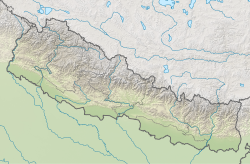Lumbini
लुम्बिनी | |
|---|---|
 Maya Devi Temple, Lumbini, marking the Buddha's birthplace | |
| Coordinates: 27°28′53″N 83°16′33″E / 27.48139°N 83.27583°E | |
| Country | Nepal |
| Province | Lumbini Province |
| District | Rupandehi |
| Municipality | Lumbini Sanskritik |
| Government | |
| • Type | Development trust |
| • Body | Lumbini Development Trust |
| Elevation | 150 m (490 ft) |
| Time zone | UTC+05:45 (NST) |
| Postal code | 32914 |
| Website | www |
| UNESCO World Heritage Site | |
|---|---|
| Location | Rupandehi District, Nepal |
| Criteria | Cultural: iii, vi |
| Reference | 666 |
| Inscription | 1997 (21st Session) |
| Area | 198.95 ha |
| Buffer zone | 22.78 ha |
| Coordinates | 27°28′53″N 83°16′33″E / 27.48139°N 83.27583°E |


| Pilgrimage to |
| Buddha's Holy Sites |
|---|
 |

Lumbinī ([लुम्बिनी] Error: {{Langx}}: invalid parameter: |IPA= (help) pronounced [ˈlumbini] , "the lovely") is a Buddhist pilgrimage site in the Rupandehi District of Lumbini Province in Nepal. According to the sacred texts of the Buddhist Commentaries, Maya Devi gave birth to Siddhartha Gautama in Lumbini in c.624 BCE.[a][2][3] Siddhartha Gautama achieved Enlightenment, and became Shakyamuni Buddha who founded Buddhism.[4][5][6] He later passed into parinirvana at the age of 80 years, in c.544 BCE.[7][8] Lumbini is one of four most sacred pilgrimage sites pivotal in the life of the Buddha.[9]
Lumbini has a number of old temples, including the Mayadevi Temple, and several new temples, funded by Buddhist organisations from various countries. Most of the temples have already been completed and some are still under construction. Many monuments, monasteries, stupas, a museum, and the Lumbini International Research Institute are also near to the holy site. The Puskarini, or Holy Pond, is where Mayadevi, the Buddha's mother, is believed to have taken the ritual bath prior to his birth and where the Buddha also had his first bath. At other sites near Lumbini, earlier Buddhas were born, then achieved ultimate Enlightenment and finally relinquished their earthly forms.[10]
Lumbini was made a World Heritage Site by UNESCO in 1997.[2][3][note 1]
- ^ Le Huu Phuoc, Buddhist Architecture, p.269
- ^ a b Centre, UNESCO World Heritage. "World Heritage Committee Inscribes 46 New Sites on World Heritage List". UNESCO World Heritage Centre.
- ^ a b "Lumbini, the Birthplace of the Lord Buddha". UNESCO. Retrieved 1 March 2011.
- ^ "Lumbini, the Birthplace of the Lord Buddha – UNESCO World Heritage Centre". Whc.unesco.org. Retrieved 19 August 2013.
- ^ ""Gautama Buddha (B.C. 623-543)" by T.W. Rhys-Davids, The World's Great Events, B.C. 4004-A.D. 70 (1908) by Esther Singleton, pp. 124–35".
{{cite journal}}: Cite journal requires|journal=(help) - ^ "The Buddha (BC 623-BC 543) – Religion and spirituality Article – Buddha, Bc, 623". Booksie. 8 July 2012. Retrieved 19 August 2013.
- ^ Cousins, LS (1996). "The Dating of the Historical Buddha: A Review Article". Journal of the Royal Asiatic Society. 6 (1): 57–63. doi:10.1017/s1356186300014760. JSTOR 25183119. S2CID 162929573. Archived from the original on 20 December 2010.
- ^ Schumann, Hans Wolfgang (2003). The Historical Buddha: The Times, Life, and Teachings of the Founder of Buddhism. Motilal Banarsidass Press. pp. 10–13. ISBN 8120818172.
- ^ "The Eight Great Sacred Sites", Nekhor: Circling the Sacred, Samye Translations.
- ^ Cite error: The named reference
:0was invoked but never defined (see the help page). - ^ Mishra, Ramakanta (December 2021). "Location of Kapilavastu: Resolving Contradictory Descriptions found in Buddhist Scriptures". Journal of the U.S. Sangha for Buddhist Studies. 02 (2): 64–76. ISSN 2692-7357.
Cite error: There are <ref group=lower-alpha> tags or {{efn}} templates on this page, but the references will not show without a {{reflist|group=lower-alpha}} template or {{notelist}} template (see the help page).
Cite error: There are <ref group=note> tags on this page, but the references will not show without a {{reflist|group=note}} template (see the help page).

